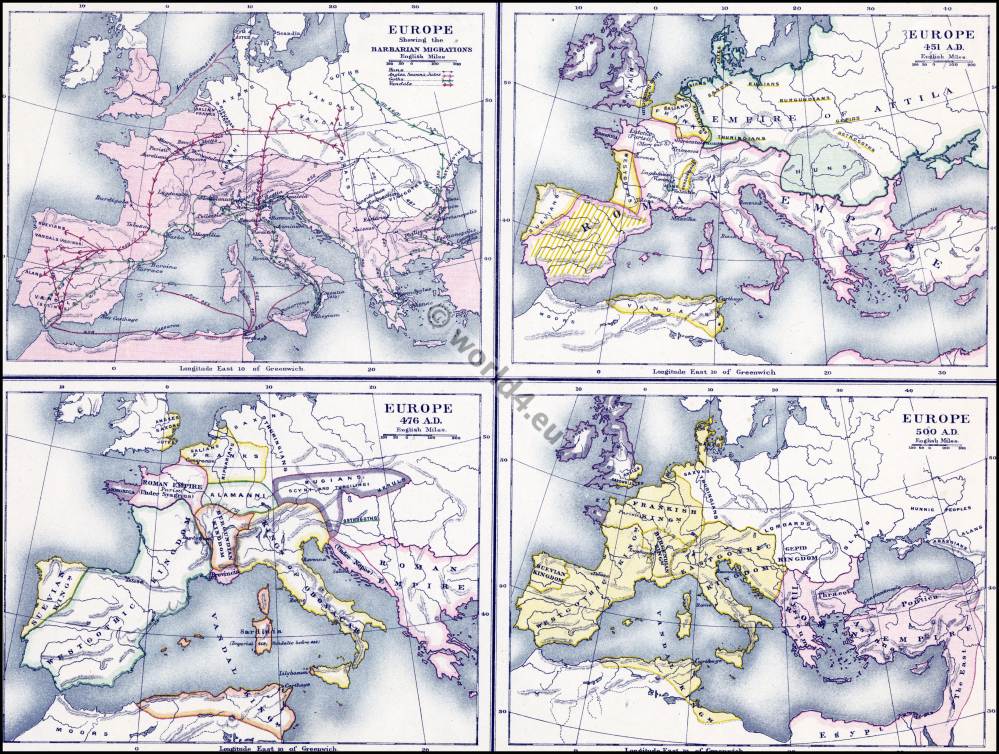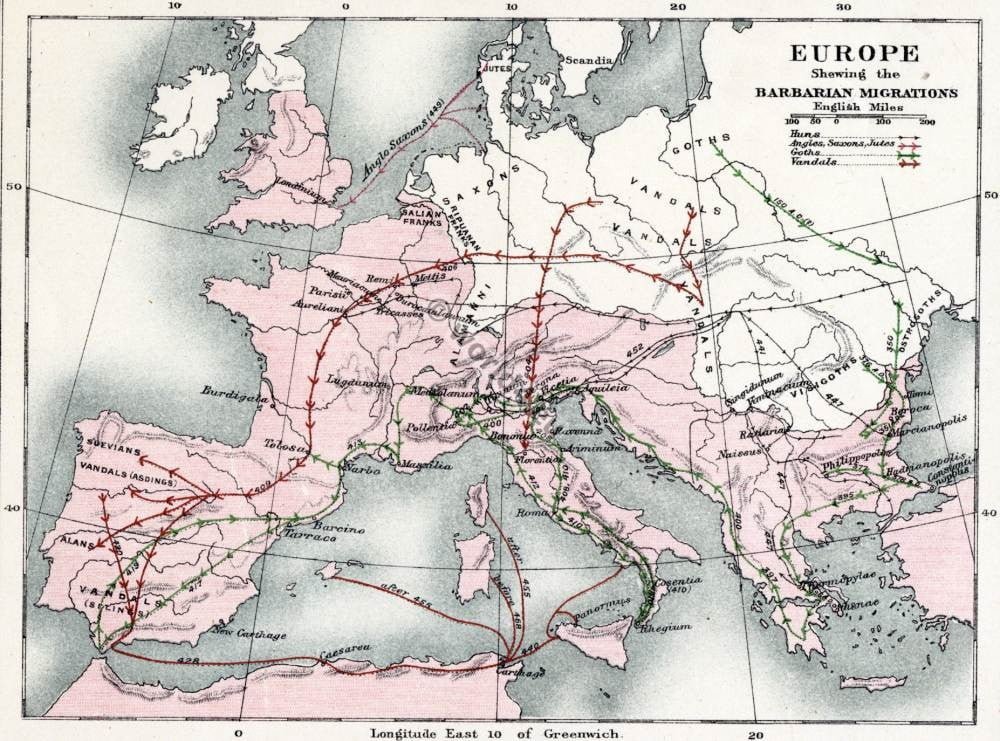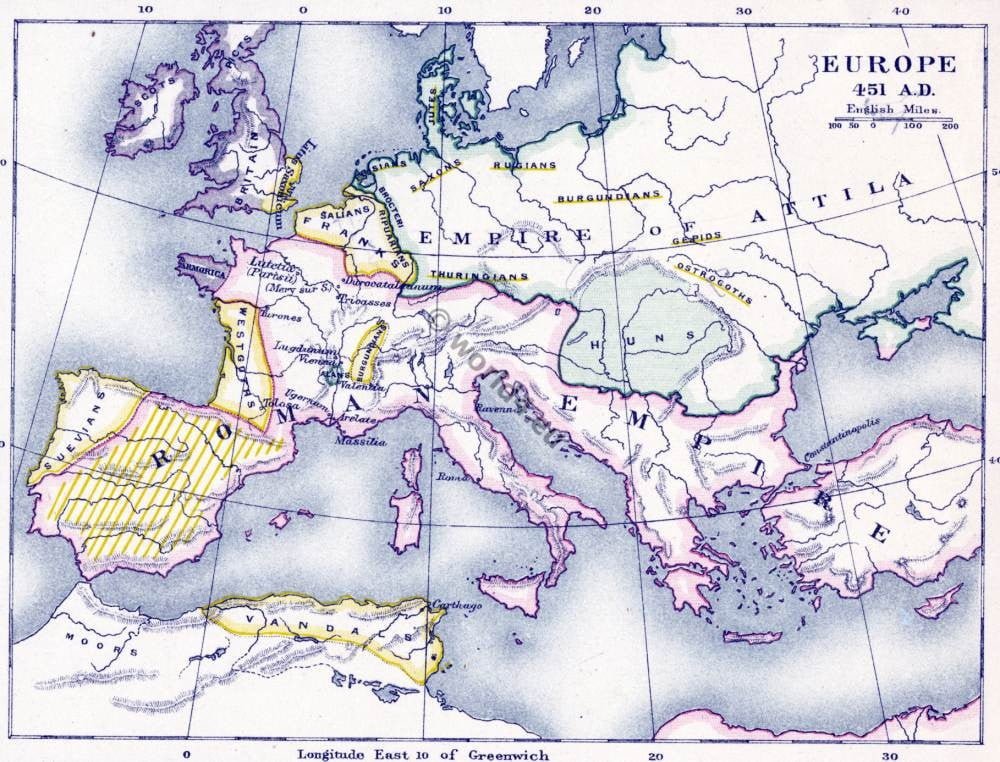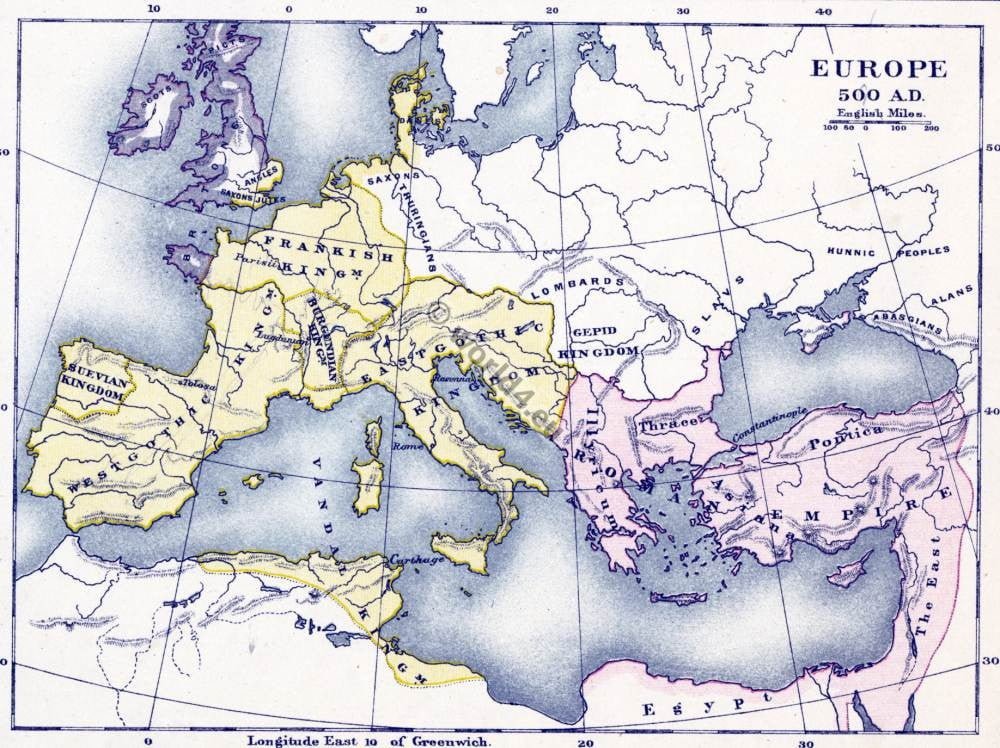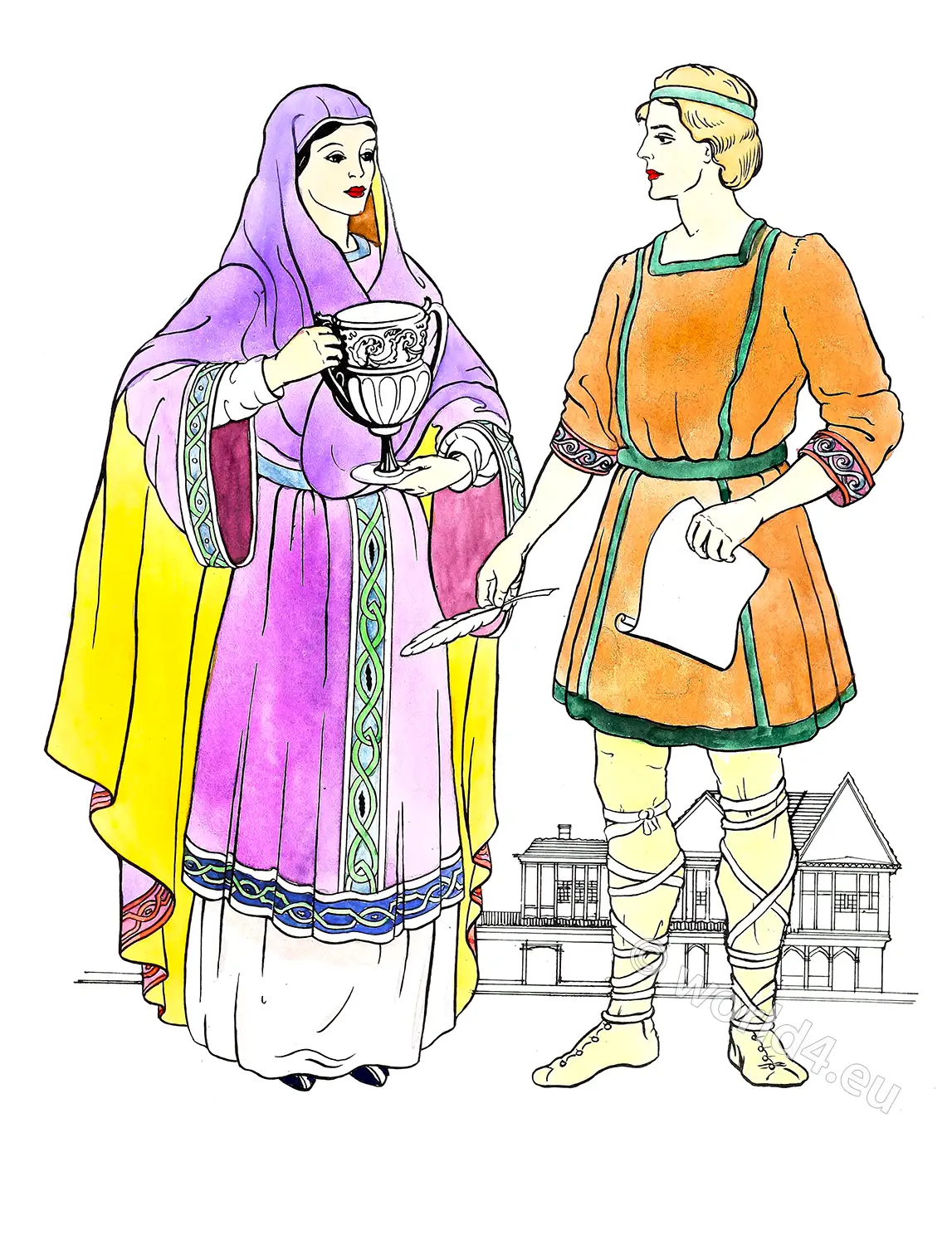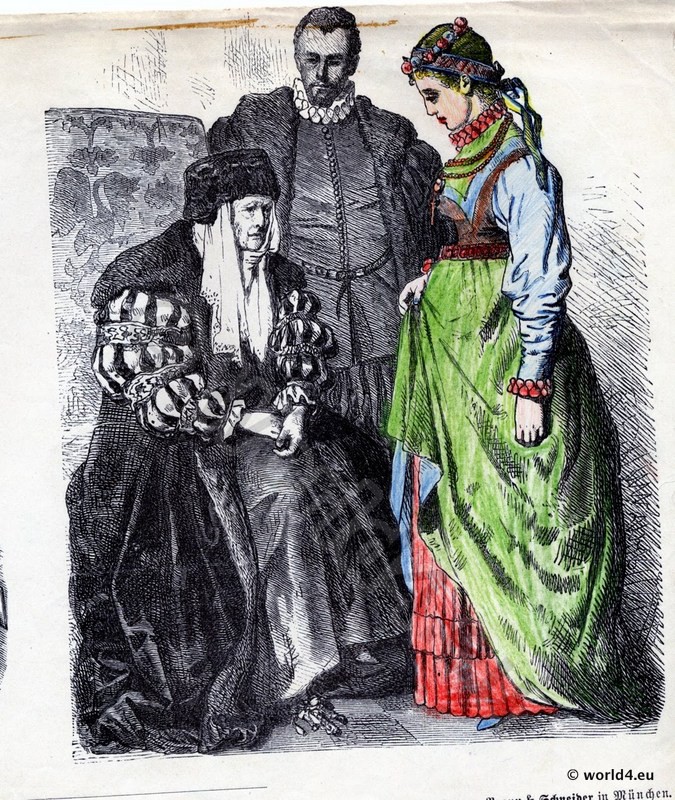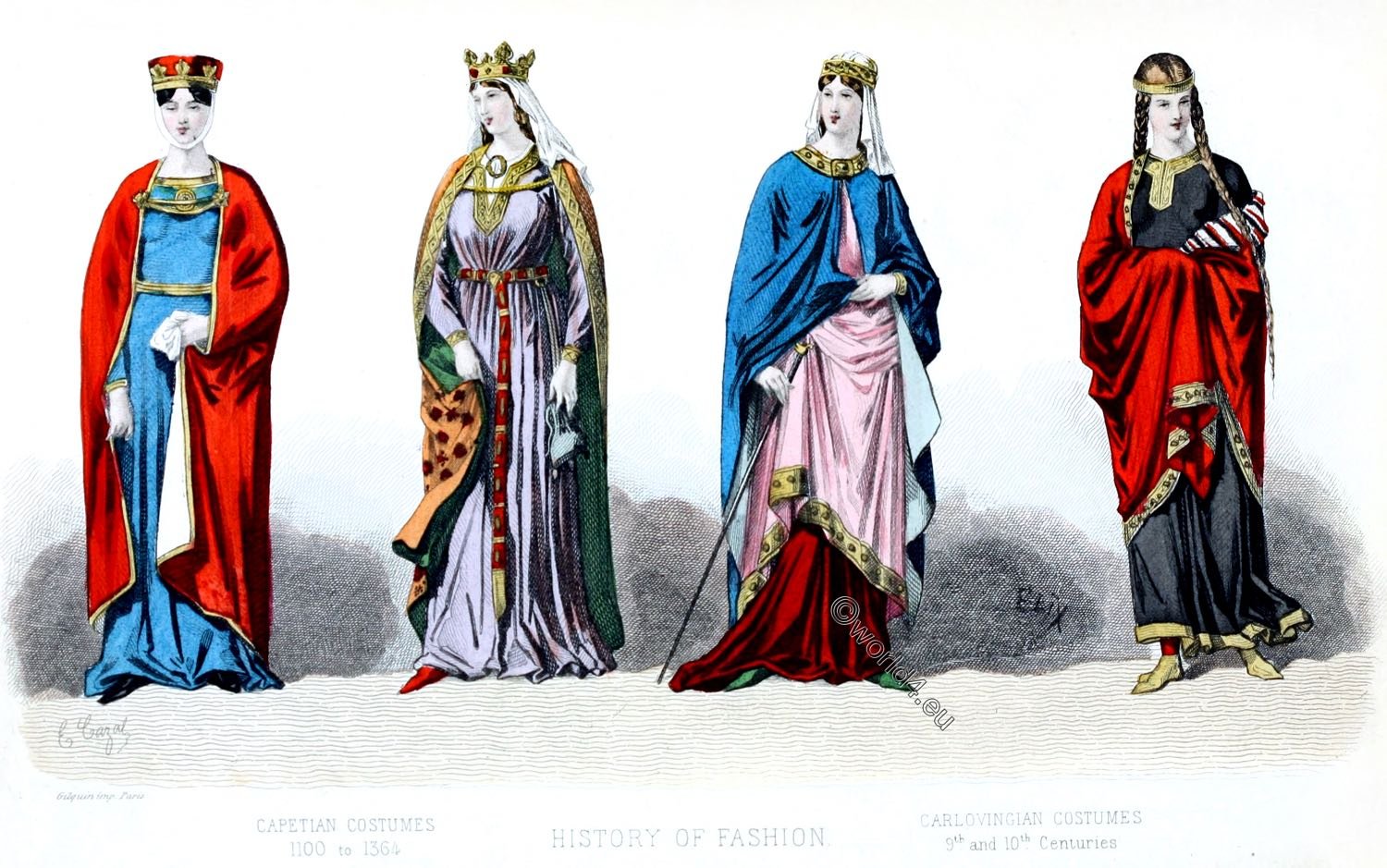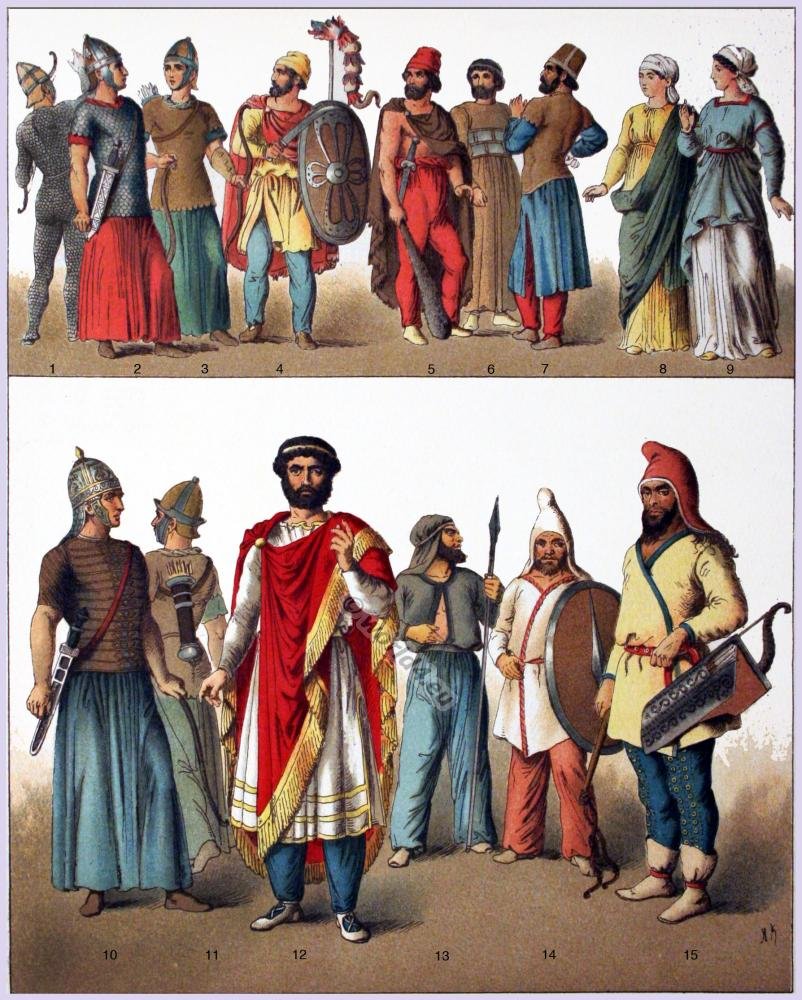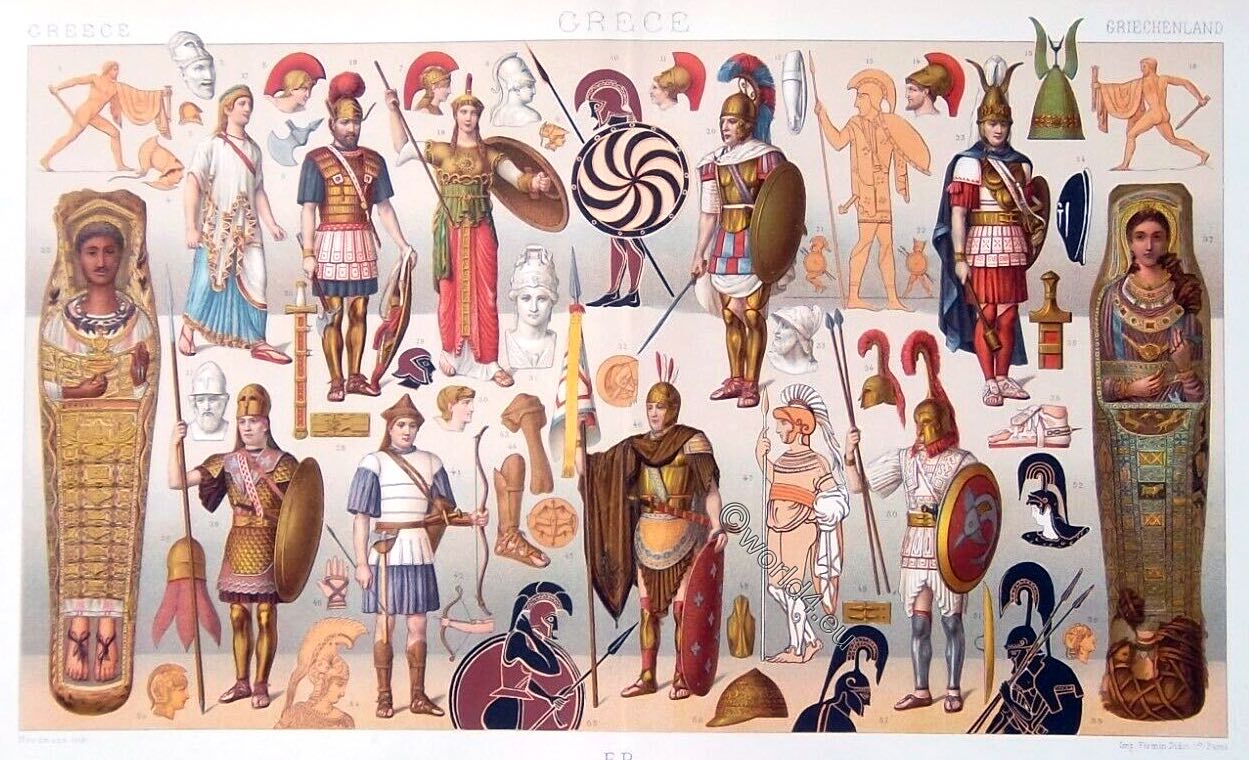Content
The Barbarian Invasions.
The Migration Period in Europe, 395-527 A. D.
ON the death of THEODOSIUS THE GREAT, in 395 A.D., the Empire was divided between his sons. Flavius Arcadius taking the eastern, Flavius Honorius the western, half. Four Prefectures have now become a fixed territorial division; the realm of Honorius embraces the Prefectures of Gaul and Italy, that of Arcadius the Prefectures of Illyricum (Illyria) and the East (The Diocese of Western Illyricum belongs to the Prefecture of Italy.).
About the same time the invasion of Greece by the Visigoths under Alaric I (396 A. D.) began the series of movements which resulted in the breaking up of the western half of the Empire into German kingdoms-the great historical feature of the fifth century.
Formation of the German Kingdoms
1. Invasions of the Barbarians and formation of the German Kingdoms.
I. The Diocese or Britain was the first loss sustained by the Empire. In 407 A. D. the tyrant CONSTANTINE crossed into Gaul with the Britannic army, and the Romans never resumed possession of the island, in which the Saxons, Angles, and Jutes soon made abiding settlements.
Barbarians crossed the Rhine
2. About the same time a mixed band of barbarians crossed the Rhine, ravaged their way through Gaul, and in 409 A. D. entered Spain. This band consisted of Vandals, Suevians (Suebian, Caesar treated them as one Germanic tribe), and Alans. (a) The Vandals were a German people, who, to judge from their proper names, were closely related to the Goths. From their original home between Oder and Vistula they had penetrated southward into the land between the Danube and Theiss (Iazygia), and received settlements in Pannonia from the Emperor Constantine. They were distinguished into two tribes, the Asdings and Silings.
The Asdings took up their abode along with (b) the Suevians, a Teutonic people of Central Europe, in the north-western regions of Spain, while the Silings occupied Baetica. (c) The Alans, a body of adventurers belonging to a race which lived north of the Caucasus, an eastern part of the Sarmatian tribe and probably did not belong to the Indo-Germanic family, settled in Lusitania.
This geographical distribution (410-416 A. D.) of the invaders of Spain was changed by the appearance of the Visigoths or West Goths on the scene (see below, § 3). They performed a service to the Empire by delivering Lusitania from the Alans and Baetica from the Silings (417-419 A. D.). But Baetica was hardly rescued before it was occupied by the other Vandal tribe, the Asdings, who had quarrelled with the Suevians. Roman attempts to recover Baetica failed; but in 429 A. D. the Vandals (along with the remnant of the Alans) abandoned Spain and crossed into Africa. (It was formerly held that the name Andalusia was a relic of the Vandal lordship in Southern Spain, but strict philology cannot allow the development of Andalusia from Vandalusia.)
Throughout this period Eastern Spain, the province of Hispania Tarraconensis, had not been occupied by the barbarians, though it was exposed to their depredations; and it remained Roman until the conquest of the Visigoths in 456. The Suevian kingdom was firmly established in Gallaecia, and probably extended into Lusitania.
The condition of Spain at this time (429-456) is very obscure; but it would seem that Suevian settlements were made in Baetica, though the important towns were in Roman hands.
The Visigothic invasions of Italy.
3. Aquitania. The Visigothic invasions of Italy (400- 402 and 408-412 A .D.) like the Visigothic invasion of Greece, led to no geographical changes. But having left Italy the Visigoths advanced to the Pyrenees, and, in the north-east corner of Spain. Barcino (Barcelona) was the capital of their First Kingdom in the West (413-419 A.D.).
Having fought successfully in Southern Spain against the Vandals and Alans, they received from the Roman Emperor Honorius a large territory in South-West Gaul, consisting of Aquitania II, the northern part of Narbonensis, part of Novempopulana (Latin for “country of the nine peoples”). The town of Narbo Martius was expressly reserved (Narbonne was the first Roman colony outside Italy. It was built around 118 BC. as Colonia Narbo Martius.). Thus was formed the Second Visigothic Kingdom, with Tolosa as its chief city. It was within, recognized by, and tributary to, the Empire; so that theoretically Gaul was still entirely Imperial.
The Visigoths gradually extended the boundaries of their kingdom-in the north, to the Loire-during the following years. The decline of the power of the Empire enabled them to conquer Spain in 456; so that by 460 their realm extended from the Loire to the Straits of Gades, with the exception of the Suevian kingdom. This was the Third phase of the Visigothic kingdom, having Toletum (Toledo) as its chief city. The lands of Arverni were ceded by the Empire in 475; and Provincia (see below, § 6) became Visigothic between 481 and 489; so that in 490 the Visigothic kingdom reached its widest extent. But in hardly more than half a century it was cut short in the north.
The result of a war with the Franks (507-510 A. D.) was that the lands between the Loire and the Garonne-the greater part of Visigothic Gaul-were lost to the Visigoths, and became part of the Frankish kingdom.
Vandals under Gaiseric.
4. Africa was invaded by the Vandals under Gaiseric in 429 A. D., and their conquest was rapid. In 435 A. D. the Imperial government adopted the same policy which had been adopted in the case of the Visigoths, and recognized a tributary Vandal kingdom in the Diocese of Africa. A compact was made by which the province of Africa (with the exception of Carthage herself), Byzacena, and part of Numidia, were ceded to the invaders. But this arrangement did not last long. In 439 Carthage was taken by the Vandals, and the loss of Roman dominion in Africa followed.
The kingdom of the Vandals soon became insular as well as continental; they followed in the steps of their Phoenician predecessors. Before 468 A. D. Sardinia, Corsica, and the Balearic Islands were conquered, and a foothold was secured in the Phoenician corner of Sicily at Lilybaeum (an attempt to take Panormus failed). Sardinia was recovered for the Empire in 468 A. D., but before 484 A. D. was reconquered by the Vandals.
Western Mauretania was not included in the Vandal realm; it was left to the Moors. It is worth noticing that the usual idea that the Vandals crossed into Africa by the Straits of Gades must be false; they were not likely to undertake a long, laborious, and unprofitable journey through Mauretania. They must have sailed to Caesarea, or somewhere in the neighbourhood.
The Huns.
5. The Huns (Asiatic nomads belonging to the Turkish family), whose previous history and ethnicity is unknown or disputed in modern research, came into prominence at the beginning of the fifth century. Having made a settlement in the regions of the river Theis, they extended their sway, east and west, over many Teutonic and non Teutonic peoples; and at length under ATTILA a Hunnic Empire was formed, which united, in various degrees of real and nominal dependence, the inhabitants from the Rhine to the Volga, from the Danube to the Northern Sea.
The Illyrian provinces were ravaged by the Huns repeatedly (441, 447); but in 451 the Hunic power received a decisive check at Maurica in Champagne (Mery-sur-Seine), from the combined forces of the Empire and the Visigoths. An invasion of Northern Italy in the following year is said to have led to the foundation of Venice by fugitives before the advance of the barbarians. After Attila’s death the Hunnic Empire was dissolved by the revolt of its German vassals; the Huns were defeated and dispersed on the field of Nedao (A river in Pannonia. The present name of the river Nedao is unknown) 454 A. D.
The battle of the Nedao led to considerable changes in the distribution of the barbarians on the Danube frontier. (a) The Gepidae (Latin Gipedae), a German people, of the same branch as the Goths and Vandals, occupied Dacia and probably Iazygia (The Iazyges also Jazygier, (Latin Iazyges, Greek Ἰάζυγες) were a tribe of Sarmatians. Greek Σαρμάται). (b) The Ostrogoths or East Goths settled in Pannonia. Other German peoples (c) Heruls, (d) Scyri, (e) Rugians, and (f) Turcilingi, occupied the countries north of the Middle Danube, but it is impossible to arrange them with certainty on the map. The Alamanni had settled in the northern part of Raetia, and their northern neighbours were the Thuringians.
The Emperors at Ravenna.
6. Italy. Noricum was exposed (454-476 A.D.) to the ravages of the Rugians and their fellows, and through Noricum they harried Italy. From them the Emperors at Ravenna recruited foederati, and under ODOVACAR,* a German (of unknown nation), they erected a German kingdom in Italy, compelling the Emperor ROMULUS AUGUSTULUS to resign, 476 A. D. The Empire in the West had, however, not yet passed completely into the power of the Germans; there was still a Western Emperor.
JULIUS NEPOS (Recognized by the Eastern Emperor Flavius Zeno, Tarasicodissa. Julius Nepus was the last legitimate Emperor of the Western Roman Empire 474/475.) maintained himself in Dalmatia, and was acknowledged in Provincia till his murder in 480 A.D.
* Odoacer also Odowakar or Odovakar, in Old High German glosses Otacher, and in the form Otachre in Hildebrand’s song, Latin Flavius Odovacer, Odovacar or Odovacrius (born about 433; died probably on March 15, 493 in Ravenna), was a Western Roman officer of Germanic origin and after the deposition of Romulus Augustus became the first King of Italy 476–493 (Rex Italiae).
The Kingdom of Odovacar embraced Italy, Raetia, Noricum, and Sicily in 476; Dalmatia was annexed in 481. Whether Provincia was ever actually ruled by him is uncertain; but at an unknown date (after 480) it was ceded by him to the Visigoths. Theoretically, Odovacar acknowledged the supremacy of the Roman Emperor.
The Ostrogoths, who had harried in the Illyrian Prefecture and vexed the government of Leo and Zeno (just as the Visigoths under Alaric had vexed the government of Arcadius), received a mandate from Zeno to recover Italy for the Empire. Under THEODORIC * they won Northern Italy in 489; Ravenna fell in 493; and the Ostrogothic Kingdom was established.
* Theodoric, called the Great (Flavius Theodericus Rex; Greek: Θευδέριχος; to 451/56 in Pannonia; died on 30 August 526 in Ravenna, Italy), was a rex (Ruler) of the Ostrogoths from the family of the Amali. Theodoric, who is considered one of the most important personalities of the Migration Period, also functioned temporarily as a ruler of the Visigoths and ruled after his victory over Odoacer in Italy. His name is in the Gothic-Þiuda reiks, “ruler of the people” (hence Theuderik or Theoderik). Theodoric is regarded as the historical model for Dietrich von Bern (“Theodoric of Verona”) in the medieval Germanic heroic poetry.
Sicily.
7. Sicily seems to have remained Roman until within a short time of the revolution of Odovacar, with the exception of Lilybaeum (the ancient name of the city of Marsala), which had been captured by the Vandals. But it seems for a moment to have passed entirely, whether nominally or actually, into the power of the Vandals (perhaps ceded in 475); for in 476 the Vandals gave it up, on condition of tribute, to Odovacar, with the reserve of the western corner.
With Italy it passed into the power of the Ostrogoths, and the Vandals were driven out from the part which they had retained.
The Ostrogothic kingdom.
8. The Ostrogothic kingdom, under Theodoric (493-526), was more extensive than that of Odovacar, for it embraced Pannonia and the western corner of Sicily. In 510, by the battle of Arles, Theodoric won Provincia (as far as the Durance), and in 523 (allying himself with the Franks) he won the small remnant of Provincia and part of what is now the Dauphiné from the Burgundians.
Besides this, as protector of his grandson Amalaric, he ruled the whole Visigothic realm from 510 to his death (526). Thus during that period a great Gothic kingdom, from Dalmatia to the Atlantic, had preponderant power in the West.
The Salian Franks.
9. Gaul.
The Salian Franks (who probably represent the old inhabitants of the regions between the Scheld and Lower Rhine-the Batavi and Canninefates-perhaps reinforced by immigrants from the East) occupied Toxandria * in the time of Julian, and when conquered retained it, paying tribute to Rome. But fifty years later, at the beginning of the fifth century, the land had ceased seriously to be regarded as Roman, and we find the Salians on both sides of the Scheld, Their king Chlojo extended his sway to the Somme; Cameracum (Cambrai) and Tornacum (Tournai) became residences of the Frank kings (date uncertain, but before 455).
* Toxandrien is the historical name for a region in North Brabant. It lies between the rivers Maas, Schelde and the Dijle in the Belgian-Dutch border region.
Burgundian kingdom.
Meanwhile the First Burgundian kingdom on the Rhine (including Mainz and Worms) had been overthrown by Aetius, and the conquered Burgundians settled in Sapaudia (Savoy), A. D. 437. This Second Burgundian kingdom extended westward, at the expense of the Empire, beyond the Rhone. Its capital was Lugdunum, Latin name of Lyon, France.
The small state of the Alans which was formed, by permission of the Empire, round Valentia in 440, was absorbed in the Burgundian kingdom. Provincia, which remained Imperial till the death of Nepos (480), passed within the next ten years to the Visigoths. Thus in 490 the Burgundians had as neighbours the Visigoths in west and south, the Franks in the north, the Ostrogoths, who were conquering Northern Italy, in south-east, and in the north-east the Alamanni, who had occupied the lands formerly held by the Burgundians.
Pannonia.
10. Pannonia, in which CONSTANTINE THE GREAT had assigned settlements to the Vandals, was ceded by VALENTINIAN III to the Huns, before 448 A. D., and was occupied after the battle of the Nedao by the Ostrogoths (454).
The Empire.
II. The Empire.
In describing the advance of the Germans, the retreat of the Empire has been told by implication. After 480 it consisted only of the Prefectures of Illyricum and the East; after 486 it had not even the nominal dominion over the lands of Syagrius in Gaul. It is only necessary to call attention to two points. (I) From the beginning of the continuous dual Emperorship at the death of Theodosius I to its cessation on the death of Nepos (395-480 A.D.), the Empire was always regarded as a unity (precisely as in the case of Valentinian and Valens, &c.), ruled by a collegium of two or more Emperors.
Thus in the interval between the death of Honorius and the accession of Valentinian III, the whole Empire was theoretically ruled by Theodosius II. The unity was expressed in (a) the joint edicts and (b) the consulship. (2) As a rule, the German kingdoms were established formally as dependent on the Empire, under conditions definitely drawn up. Hence the Imperial government regarded the lost dominions in the West as still part of the Empire, it being only a question of power and opportunity to reassert the Imperial authority. Theoretically Odovacar was dependent on Zeno; theoretically Theodoric reasserted Zeno’s authority in Italy.
On the Eastern frontier there were some small shiftings in the reign of Anastasius, but it need only be mentioned that under Justin (518-527) Lazica became dependent on New Rome.
By John Bagnell Bury
Source: Historical atlas of modern Europe from the decline of the Roman empire: comprising also maps of parts of Asia and of the New world connected with European. Author: Poole, Reginald Lane. Edited by Reginald Lane Poole. Publisher: Oxford: Clarendon Press; London; New York: H. Frowde.
Related
Discover more from World4 Costume Culture History
Subscribe to get the latest posts sent to your email.

